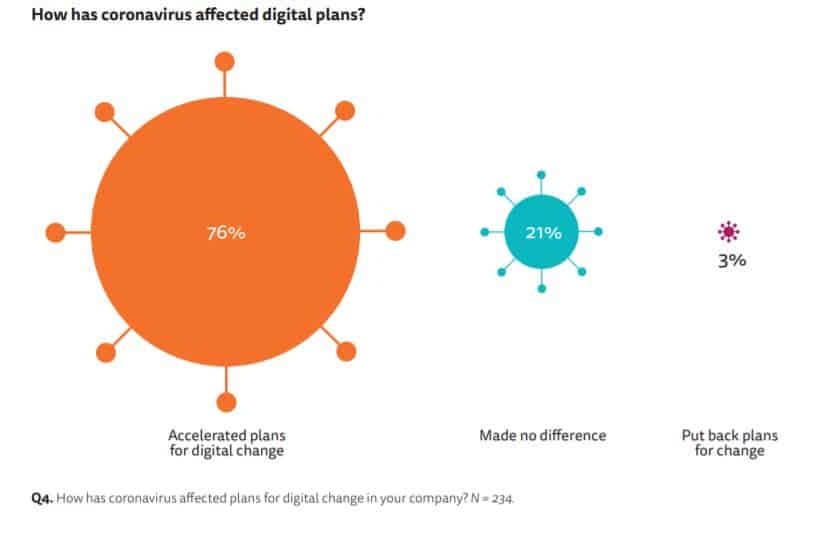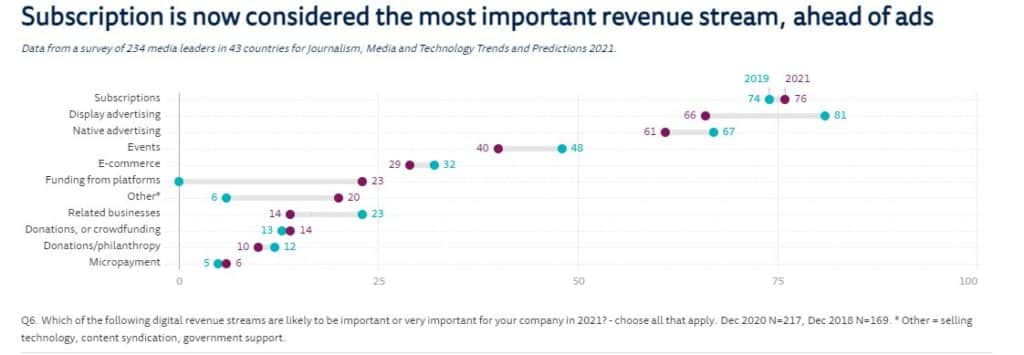Digital transition, diversified revenue streams, increased engagement across multiple channels and a remote working future – these are the key themes of Reuters’ 2021 Journalism, Media, and Technology Trends and Predictions. So how do these relate to media organisations with highly targeted audiences?
The Reuters Institute for the Study of Journalism has released its predictions for 2021 media trends. The report focuses on the survey responses of 234 news organisations across the world, with some interesting takeaways for print and digital B2C and B2B targeted media brands, including magazines.
Author Nic Newman, the Institute’s Senior Research Associate, predicts that 2021 will be a year of “economic reshaping” for the media industry, leading publishers to pursue subscription and e-commerce business models, which he says have been “supercharged by the pandemic”.
Of the sample of editors, CEOs and digital leaders surveyed for the report, three-quarters said that COVID-19 has accelerated their plans for a digital transition, with their business plans including more remote working and/or a faster switch to reader-focused business models.

Let’s dive into the report’s findings and predictions that are most relevant to media brands with highly targeted audiences.
Digital transition
2020 saw publishers innovate by moving their workflows online, rethinking existing products and creating new formats for news delivery. The Reuters report found that most news media brands stripped back the usual bureaucracy around testing and approving new products and formats to act quickly in the face of the changes brought about by COVID-19.
In particular, the report highlights audience insight and data driving innovation for three-quarters of publishing companies surveyed – along with multi-disciplinary teams led by ‘product managers’ working to break down the silos of editorial, sales, marketing and web development to increase agile development.

Newman predicts that publishers will use their audience data to focus on better user experience and design of their digital platforms in 2021, with 70 per cent of respondents planning to focus on improving their existing brands over developing new products due to cost restraints.
Seamless user experiences around website login, subscription management and customer service for publishers is needed to keep up with the service provided by mainstream subscription services like Netflix, Newman says, in addition to a focus on increasing engagement and subscriber retention.
First-party data collection remains a priority as larger publishers navigate the end of third-party cookies, which will have an impact on the ability for online advertisers to track and measure their ad spend. Newman predicts that most publishers will overcome this by asking users to register before accessing content in 2021.
The takeaways for smaller, targeted media organisations here lie in capturing and using audience data to inform product decisions and improve user experience. Most smaller publishers already operate in a fairly dynamic way with multi-disciplinary teams, but not all publishers are capturing useful first party data to help inform decisions about their product. I see this as a key opportunity for targeted media brands.
Remote working
Remote working arrangements necessary to reduce the spread of COVID-19 saw publishers create print, web, audio, and broadcast content from home using cloud-based tools. Some respondents found that these tools improved their internal communication, co-ordination and transparency – allowing them to operate more efficiently than if they were working together in the office.
The adoption of cloud-based tools to drive efficiency is a key theory promoted by editorial workflow expert Kilian Shalk who is launching an Australian course on the topic in February this year.
Half of the survey respondents had plans to downsize their physical offices based on the success of staff working remotely, and to save costs.
The flipside of this is the mental health of staff working remotely, and the ability for managers to communicate difficult conversations effectively, with 77 per cent of those polled stating that working remotely has made it harder to maintain working relationships.
Diversified revenue
Revenue diversification is a key theme within the report. On average, publishers surveyed are planning to rely on four different ‘important’ or ‘very important’ revenue streams.
Over three quarters (76 per cent) of the report’s sample rated digital subscriptions as an important or very important revenue focus for 2021 – ahead of display advertising and native advertising. This is a significant increase on last year’s survey results, where half planned to focus on reader revenue as their main source of income.

Newman states “The COVID-19 shock has reinforced a view that the industry needs to break an unhealthy dependence on digital advertising, which is blamed amongst other things for encouraging clickbait, reducing quality, and creating a poor user experience.”
Newman warns that “those publishers that continue to depend on print revenues or digital advertising face a difficult year – with further consolidation, cost-cutting, and closures.”
It’s worth noting here that most news organisations receive digital revenue through programmatic advertising platforms, as opposed to the contextual directly-sold digital advertising served by media brands with smaller, targeted audiences. Studies have shown that contextual advertising performs better than other ads, so Newman’s take is likely not as dire for targeted media brands.
Paid digital subscriptions
A key trend of the report is the move toward digital subscriptions and reader revenue. Newman explains that Reuters 2020 Digital News Report found that the majority of reader revenues tend to lie with large national and international news media brands.
He says that where smaller brands have been successful, they have “relentlessly focused on meeting specific audience needs”, finding that readers are willing to pay for convenience, connection, and a sense of community – aspects that most niche media brands with targeted audiences are adept at fostering.
But the fact remains, that “for many publishers, growth in digital subscriptions won’t be nearly enough to compensate for substantial falls in…print and digital advertising revenue.” And, as more publishers promote paid subscription offers, subscriber competition and retention will become an issue, with Neman predicting that publishers will respond with cut-pricing options and differential pricing (student pricing, etc).
E-commerce
The report predicts that publishers will start to look more like retailers in 2021, with publishers looking to cash in on the expected $7 trillion in global ecommerce spend over the next four years via affiliate partnerships.
“Publishers are increasingly thinking about how they can get a chunk of this growth by curating content that creates the right intention to buy.”
Newman states that several digital news publishers are making “significant contributions” to their bottom line from affiliate revenue “with the additional benefit of collecting valuable first-party data”.
While this sounds attractive, media brands with smaller audiences will need to look for high-commission affiliate agreements to generate decent revenue, and it may only be an option for those who publish on topics that lends themselves to affiliate products.
Events
The report also predicts that live events – whether virtual or physical – will drive both B2C and B2B publisher revenues during 2021.
“Publishers have found that virtual events can be spun-up more quickly, with a lower cost base, higher profile guests, and a bigger audience than a physical event,” Newman states.
We’ve seen this in the Australian market – with several B2B publishers producing professional virtual event packages – some even developing their own software.
Newman expects to see continued “professionalisation around the production and packaging of these events – as well as new features that help deliver more compelling online experiences”, and while physical events will make a comeback “the future is likely a hybrid one”.
Increased engagement
The report predicts that e-newsletters and podcasts will remain key tools for traditional media companies to engage with their audiences more directly.
“Data insights consistently show that signing up for a relevant newsletter is the best way to reduce churn for existing subscribers or develop new relationships with potential customers,” states Newman.
The report also found that large news media organisations have recognised the move toward ‘journalist-led’ emails – the rise of high-profile writers leaving traditional jobs to start their own businesses on platforms like Substack – and are encouraging writers to develop newsletters that they curate or “anchor”.
Paid podcast models are predicted to grow in 2021, largely from advertising with some shift to direct paid subscription models or donation models via Patreon, etc. These paid podcast options are likely to be bundled with digital or print subscriptions.
No silver bullet
Newman states “The pandemic has comprehensively made the case for faster change towards an all-digital future,” highlighting remote staff, collaborative online tools, and new digital formats to engage audiences.
“This will be a year when text-based newsrooms invest more heavily in online audio and video content, in data journalism, as well as the snackable visual ‘stories’ that work well on social media.”
But Newman also calls for “a deeper connection with audiences…expressing journalism across multiple channels including emails, podcast and online video” because “more direct engagement has the added benefit of attracting more first-party data which many see as the key to a sustainable future”.
I disagree with Newman that the future is “all-digital”. Print has a place – certainly magazines which can be used to foster deep connections with audiences. But I do believe that all print media needs to have a digital presence, across multiple channels to continue to grow and foster audience relationships, and to collect data to inform product development and advertising.
As Newman states, “There is no silver bullet or single solution to the revenue conundrum but there are some areas of potential growth.”
“The shock of coronavirus has been a catalyst for much-needed change for journalism as for many other industries. In the coming year we’ll find out which new habits will stick and which will prove to have been temporary. We’ll also find out which publishers have the confidence and nerve to seize the new opportunities that have emerged.”
To read the full report, visit the Reuters Institute for the Study of Journalism’s website.

